
Philip Toll Hill Jr. was an American racing driver. He was one of two American drivers to win the Formula One World Drivers' Championship, and the only one who was born in the United States. He also scored three wins at each of the 24 Hours of Le Mans and 12 Hours of Sebring sports car races.

The 1968 Belgian Grand Prix was a Formula One motor race held at the Spa-Francorchamps Circuit on 9 June 1968. It was race 4 of 12 in both the 1968 World Championship of Drivers and the 1968 International Cup for Formula One Manufacturers. The 28-lap race was won by McLaren driver Bruce McLaren after he started from sixth position. Pedro Rodríguez finished second for the BRM team and Ferrari driver Jacky Ickx came in third.
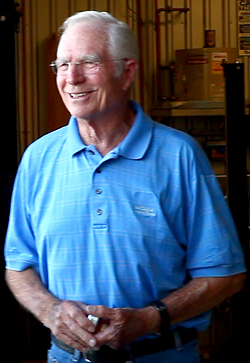
James Ellis Hall is a retired American racing driver, race car constructor, and team owner. While he is best known as a car constructor, he was one of the greatest American racing drivers of his generation, capturing consecutive United States Road Racing Championships, two Road America 500s, two Watkins Glen Grands Prix for sports cars, the 1965 Canadian Grand Prix for sports cars, the 1965 Pacific Northwest Grand Prix, and scoring a massive upset at the 1965 12 Hours of Sebring over a contingent of factory-backed Ford GTs, Shelby Daytona Coupes, and Ferrari entries. If anything Hall's accomplishments behind the wheel have been overshadowed by his pivotal contributions to race car design through his series of Chaparral sports racing and Indy cars. Hall's cars won in every series in which they competed: USRRC, Can-Am, Trans-Am, Formula 5000, World Sportscar Championship, Autoweek Championship, Canadian Sports Car Championship, and the Indianapolis 500.
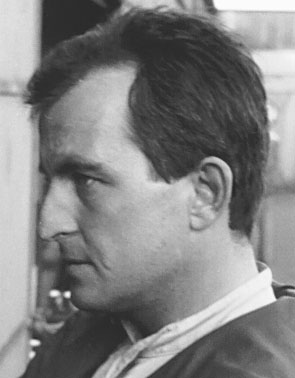
Ludovico Scarfiotti was a Formula One and sports car driver from Italy. Just prior to entering Formula One, he won the 1963 24 Hours of Le Mans for Ferrari. He later participated in 12 World Championship Formula One grands prix, and many non-championship races. He won one World Championship race, and scored a total of 17 championship points. A motor sports competitor for a decade, Scarfiotti won the 1962 and 1965 European Hillclimb Championship. He was proclaimed Italy's best driver in both 1962 and 1965.

James "Hap" Sharp was an American race car driver who drove in six Formula One Grands Prix. He was most famous however, for being a co-owner and driver of the revolutionary Chaparral sports racing cars built by Jim Hall and Sharp in Midland, Texas. In 1962 Jim Hall and Hap Sharp formed Chaparral Cars, Inc. and immediately began the design and construction of Chaparral 2, a mid-engined car with an aerospace inspired semi-monocoque fiberglass chassis.
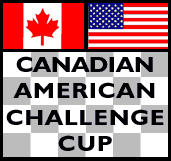
The Canadian-American Challenge Cup, or Can-Am, was an SCCA/CASC sports car racing series from 1966 to 1987.
Chaparral Cars was a pioneering American automobile racing team and race car developer that engineered, built, and raced cars from 1963 through 1970. Founded in 1962 by American Formula One racers Hap Sharp and Jim Hall, it was named after the roadrunner, a fast-running ground cuckoo also known as a chaparral bird.

The 1967 24 Hours of Le Mans was the 35th Grand Prix of Endurance, and took place on 10 and 11 June 1967. It was also the seventh round of the 1967 World Sportscar Championship.

The 1966 24 Hours of Le Mans was the 34th Grand Prix of Endurance, and took place on 18 and 19 June 1966. It was also the seventh round of the 1966 World Sportscar Championship season. This was the first overall win at Le Mans for the Ford GT40 as well as the first win for an American constructor in a major European race since Jimmy Murphy's triumph with Duesenberg at the 1921 French Grand Prix. It was also the debut Le Mans start for two significant drivers: Henri Pescarolo, who went on to set the record for the most starts at Le Mans; and Jacky Ickx, whose record of six Le Mans victories stood until beaten by Tom Kristensen in 2005.
The 1966 World Sportscar Championship season was the 14th season of the FIA "World Sportscar Championship" motor racing. It featured the 1966 International Manufacturers' Championship and the 1966 International Sports Car Championship, which were contested between 5 February 1966 and September 11, 1966, over a total of thirteen races. The International Manufacturers' Championship was open to Group 6 Sports-Prototypes and was contested in two engine capacity divisions, P1 and P2. The International Sports Car Championship was open to Group 4 Sports Cars and was contested in three engine capacity divisions, S1, S2 and S3.
In car design, ground effect is a series of effects which have been exploited in automotive aerodynamics to create downforce, particularly in racing cars. This has been the successor to the earlier dominant aerodynamic focus on streamlining. The international Formula One series and American racing IndyCars employ ground effects in their engineering and designs. Similarly, they are also employed in other racing series to some extent; however, across Europe, many series employ regulations to limit its effectiveness on safety grounds.

The Chaparral 2F is a Group 6 sports prototype designed by Jim Hall and Hap Sharp and built under their company Chaparral Cars. Built with the intention to compete in the World Sportscar Championship, it competed in the 1967 season, with a best finish of first at the BOAC 500, driven by Phil Hill and Mike Spence. The 2F, alongside its Can-Am sibling the 2E, had a heavy influence in dictating the direction of Formula One car design in the late 1960s and early 1970s. With the amounts of mechanical grip the car and tires could provide approaching their respective limits, there was a larger emphasis on aerodynamic efficiency with race car designer Colin Chapman quick to include them on his Formula One cars.
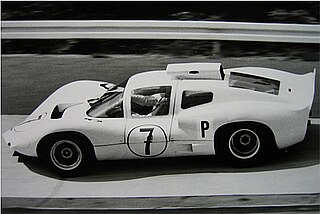
The Chaparral 2D is a Group 6 sports prototype race car designed and developed by both Jim Hall and Hap Sharp, and built by American manufacturer Chaparral, which campaigned in the FIA World Sportscar Championship between 1966 and 1967. It famously won the 1966 1000 km Nürburgring, being driven by Jo Bonnier and Phil Hill.
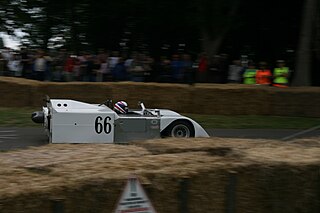
The Chaparral 2J is a sports prototype race car, designed and developed by Jim Hall and Hap Sharp, and built by American manufacturer Chaparral. It conformed to Group 7 regulations and competed in the 1970 Can-Am Championship series. It is an early example of a ground effect racing car.

The 1966 Canadian Grand Prix was a motor race held at Mosport Park on September 24, 1966, held for sports cars eligible to Can-Am Series regulations and had 30 starters. It was the sixth Canadian Grand Prix and like all previous races was a sports car race. The race doubled as round three of the 1966 Can-Am Series. The race was won by Penske driver Mark Donohue by two laps over Chaparral driver Phil Hill.
Charles W. "Chuck" Parsons was an American sports car racing driver. Parsons drove in SCCA and USSRC competition, then became a driver in the Can Am series. Like many drivers of the era, he participated in multiple venues, such as the 24 Hours of Daytona and 24 Hours of Le Mans endurance races while driving the same year in the Can Am series.
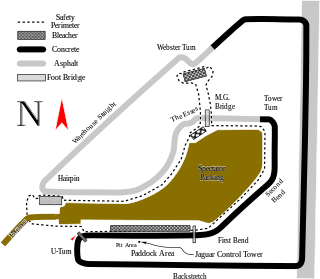
The 1966 12 Hours of Sebring was an endurance race held at the 5.2 mile (8.3 km) Sebring International Raceway, Sebring, Florida, United States on March 26, 1966. It was the sixteenth running of the endurance classic and the second round of the 1966 World Sportscar Championship season. The race proved to be a disastrous event; one of the darkest in American motorsports history.

The Zerex Special was a sports racing car. Originally a Cooper T53 built for the 1961 United States Grand Prix, it was rebuilt for usage in American sports car racing, and featured open-top bodywork. Initially using a 2.75-litre version of the Coventry Climax FPF straight-four engine, it later used a Traco-Oldsmobile 3.5-litre V8. The car won numerous races throughout its four-year career, being driven by drivers such as McLaren and Roger Penske.

The Dino 206 S is a sports prototype produced by Ferrari in 1966–1967 under the Dino marque. Ferrari intended to produce at least fifty examples for homologation by the CSI in the Sport 2.0 L Group 4 category. As only 18 were made, the car had to compete in the Prototype 2.0-litre class instead. In spite of this handicap the Dino 206 S took many class wins. The 206 S was the last of the Dino sports racing cars and simultaneously the most produced.
The 1962 Daytona Continental 3 Hour Grand Touring and Sports Car Race was an endurance race at the 6.132 km road circuit at the Daytona International Speedway, Daytona Beach, Florida, USA, that took place on February 11, 1962. It was the first race of the 1962 World Sportscar Championship.














